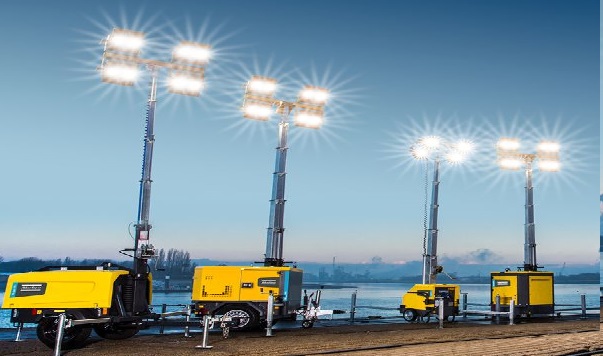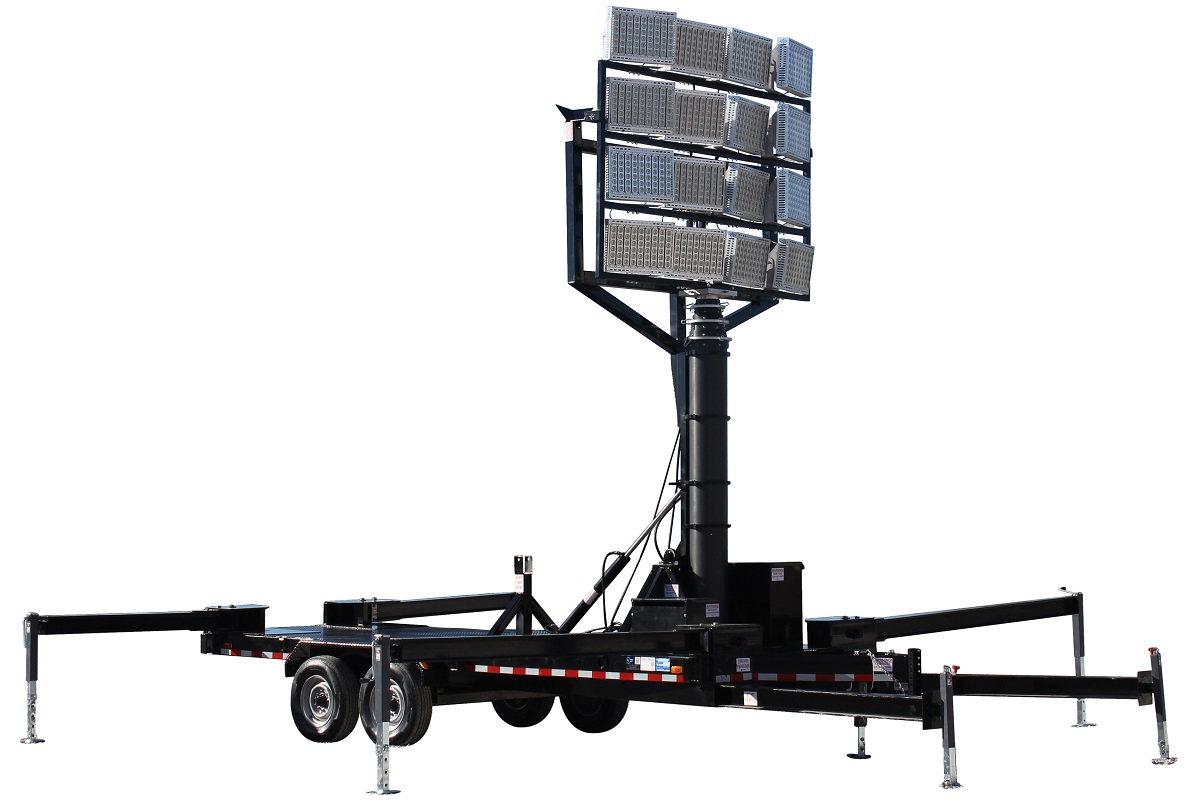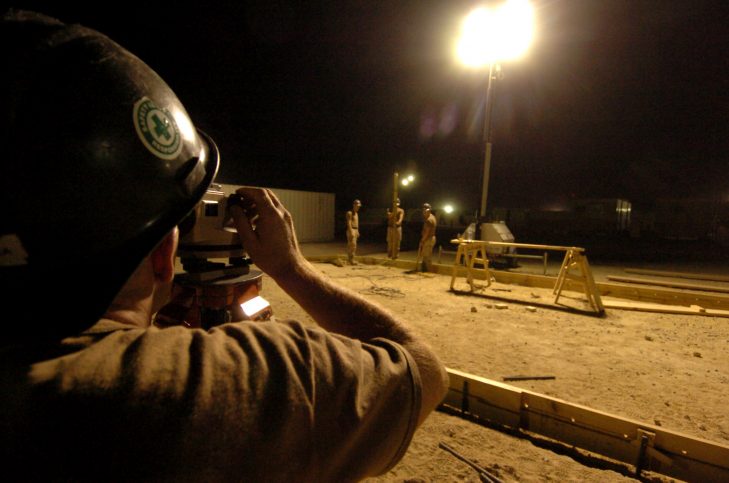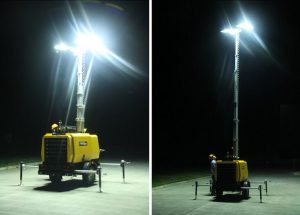1.What is light tower?
A light tower is a mobile device with one or more high-intensity lights and masts. It is almost always connected to the mast, it is connected to the trailer, and it is powered by a generator. Typically, the lamp is a metal halide bulb and the generator is powered by a diesel engine. However, battery-powered, solar-powered, and hydrogen-powered devices can be used. light towers with electrodeless lamps lighting are also sold.
Light tower are often thought of afterwards on the construction site until they need to be turned on or off. But like flashlights in dark alleys, when the sun begins to fade, the light tower is one of the most critical products on construction sites.
Light towers are essentially diesel-driven generators combined with a lighting element. In most cases, the light tower has an auxiliary power source in addition to the power source for running lights. This turns most light towers into multifunctional devices, allowing operators to use them as small generators.
2.Why the light tower is so important?
Light towers on construction sites aren’t just a convenience. They can also be an important safety measure. When you’re renting a light tower, it’s important to consider why your site needs one, how many you need, and where the towers should be placed for proper lighting. Learn more about light towers for construction sites, including the types of towers available and how to choose the right one for your site.Light towers make them an essential piece of equipment to have at construction sites. All work sites should have at least one light tower.
First and foremost, providing light for working when it’s dark, light towers make a construction site safer. Some construction companies may even use light towers during daylight hours to provide enough light for an indoor or covered work site. This way, you’re sure that your workers can easily see the equipment and tools they’re working with. This will reduce the risk of accidents or injury on the job.
Besides, light towers provide strong lighting that lets you get work done after dark. That’s a major advantage in terms of getting a job done quickly since workers won’t have to stop work once the sun sets. This allows the workday to be extended so workers can get more done each day.
Consider the different times of summer darkness and winter condensation. In most parts of the country, stopping work at sunset may reduce your working hours by a few hours, while in winter it is much earlier. Even at dawn, use the light tower, good lighting can help your workers perform tasks accurately and accurately.
Last but not least, if there are no workers around, the light tower can protect the construction site overnight. Dark construction sites may soon become the targets of theft, vandalism or other criminal activities. By keeping the lighting on site good, construction site managers can help stop criminals. In addition, if the construction site is located near a public sidewalk or road, overnight lighting can help people walk or drive safely through the site.
3.How to choose a proper light tower?
When buying a light tower, you need to ask yourself a few questions.
a. Does the job require light and power?
Why rent two pieces of equipment when a combination light tower and mobile generator can provide a single solution for two important jobsite needs? A combination machine offers necessary illumination while providing up to 20 kW of energy for powering tools, heaters or a jobsite trailer. A two-in-one machine is especially beneficial for jobsites with tight quarters and areas without a reliable power source that require light.
b. How long will you need light?
Fuel capacity is another key consideration when selecting a light tower. Large, efficient fuel tanks deliver longer run times, which translates to less downtime for refueling. Some light towers offer upward of 70 hours of run time, a major advantage when operating in remote locations. Depending on site conditions, some portable light towers may offer optional features that can provide automatic illumination — an attractive function in remote locations or when varying amounts of illumination are required.
c. How much light is needed?
Knowing the level of illumination needed for a jobsite is not only a matter of safety, but also proper budgeting. Selecting the correct light tower — or towers as the case may be — starts with determining the recommended number of foot-candles based on standards from the Illuminating Engineering Society of North America (IES). For example, 10 to 50 foot-candles are recommended for utility work while one to five foot-candles are suggested for illuminating a parking lot. Your local equipment dealer can help you calculate the remaining factors that determine the lighting needs of an application. These include the size of the area, whether light needs to be constant and how bright the light should be.
Below is an example of how to determine the lighting needs for an excavation application with an area of 800 ft by 400 ft. The IES recommendation calls for two foot-candles for this type of application.The area to be illuminated is 320,000 sq ft with two foot-candles of illumination. 320,000 sq ft x two foot-candles = 640,000A 1,000-W metal halide lamp provides an average of 0.5 foot-candles per 82,000 sq ft. 0.5 x 82,000 = 41,000. 640,000 / 41,000 = 15.6 or 16 lamps.Most light towers are standard-equipped with four lamps per light tower, which would require four light towers for this application. However, many light towers include a six-lamp option. In this instance, a six-lamp option would allow for the rental of only three light towers while still providing the appropriate level of illumination.
d. Are there lighting restrictions?
Some applications may require glare-free lights for night work or may include restrictions on fluid containment or noise level. Knowing these requirements and available light tower features can be helpful during the selection process. Correctly positioning light fixtures can significantly reduce the risk of creating a glare hazard. Floodlights at 30 ft should be positioned at a 30-degree angle from horizontal to provide optimal beam spread and reduced glare potential. Look for light towers with easily adjustable light fixtures with a locking pin system. Each light fixture should rotate horizontally and vertically to provide ideal illumination. Another option is an externally powered balloon light, which provides 2,000 W of glare-free illumination, but requires a three-prong, 20-amp outlet.
Environmental safety regulations are another consideration when selecting a light tower. Some jobsites in both the United States and Canada have established containment regulations that can include oil, coolant and fuel. Selecting a portable light tower that offers containment as part of the machine frame makes it simple to comply with those regulations, while avoiding the additional cost associated with a separate containment tray or spill pad.
4.Tips for buying or renting a light tower:
a. Lamp options
Metal halide or LED lamps are two lamp options when it comes to light towers.Metal halide lamps are cheaper to buy up front, but LED light towers are less costly to own over time as they require less power. Metal halide light towers are good for evenly lighting large sections of worksites. Metal halide lights generally take around 3 – 5 minutes to achieve full brilliancy.
LED lamps are costlier to initially purchase, but save money over time because of their reduced cost to operate. The lamps in LED lights are brighter, and the elements last longer. LED light towers typically provide more focused, concentrated light, which may be better for illuminating a specific area within a jobsite. LED lights can turn on and off quickly, with no time delay for full brilliancy.
b. Wide or narrow body equipment
Light towers come in two options – narrow body or wide body. Both styles have pros and cons. A wide body light tower is more stable and easier to tow because of its centre of gravity, whereas a narrow body light tower is more compact, but moves around more while being towed to the jobsite.
c. Size of light tower
When choosing an industrial light tower, there are two factors to consider when it comes to sizing – the size of the generator, as well as the physical size of the unit itself. When it comes to generator size, consider whether auxiliary power is needed (sometimes referred to as daisy-chaining). Light towers come in a variety of sizes, with generators typically ranging from 8kW – 20kW. Be sure to select the right generator size to avoid wetstacking. When it comes to unit size, consider your job space – does the light tower need to be compact? Congested jobsites are not only unpleasant, but are more unsafe for workers.
d. Ease of setup
When it comes to seamless and continual operations, both equipment transportation and setup can be an underrated time consumer if not properly planned. Equipment that is not ready to go when needed can have a domino effect on operations, potentially causing downtime. Consider the length of your job as well as a plan for unloading the equipment when it arrives on site. For example, on short-term jobs, vertical mast towers are often chosen because of their ease of setup in comparison to horizontal mast light towers.
5.Where to use a light tower?
Many types of work sites require light towers for practical and safety reasons. The following are some of the most common uses for light towers on construction sites:
- Welding
- Plumbing
- Electrical work
- Residential construction
- Commercial construction
- Parking areas
- Storage areas
- Industrial construction
6.How to place the light tower?
If you’re not sure how many light towers you need, you can use the following general rule of thumb. For each square foot, you’ll need about 30 watts of power. For example, a light tower with four 1,000-watt lamps can illuminate approximately 133 square feet.
Spacing out the light towers will provide proper lighting with fewer towers. Also, setting the correct angle for your light towers will allow you to get the best lighting on your construction site.In the construction industry, 30-foot floodlights are a popular choice. These lights should be positioned at a 30-degree angle. This produces the best beam spread and reduces the risk of glare, which could be dangerous when working with heavy tools and equipment.
Make sure you get the right lighting for your construction site by looking for light towers with metal halide bulbs. With proper lighting, your construction site will be safer and more efficient.








